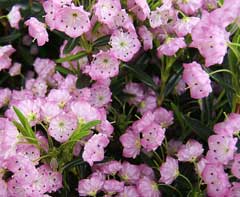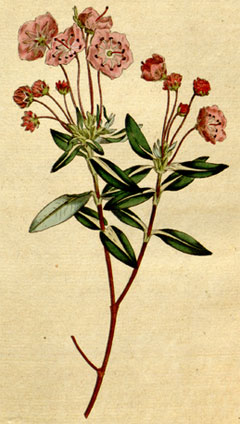 |
|
http://www.flickr.com/photos/mirjana/ |
 |
| http://commons.wikimedia.org/wiki/File:The_Botanical_Magazine,_Plate_177_%28Volume_5,_1792%29.png |
Translate this page:
Summary
Physical Characteristics

 Kalmia polifolia is an evergreen Shrub growing to 0.5 m (1ft 8in) by 0.5 m (1ft 8in).
Kalmia polifolia is an evergreen Shrub growing to 0.5 m (1ft 8in) by 0.5 m (1ft 8in).
See above for USDA hardiness. It is hardy to UK zone 2. It is in leaf all year, in flower in April, and the seeds ripen in September. The species is hermaphrodite (has both male and female organs) and is pollinated by Bees.
Suitable for: light (sandy), medium (loamy) and heavy (clay) soils and prefers well-drained soil. Suitable pH: mildly acid soils and can grow in very acid soils.
It can grow in semi-shade (light woodland) or no shade. It prefers moist soil.
UK Hardiness Map
US Hardiness Map
Synonyms
K. glauca.
Plant Habitats
Woodland Garden Dappled Shade; Shady Edge; Bog Garden;
Edible Uses
References More on Edible Uses
Medicinal Uses
Plants For A Future can not take any responsibility for any adverse effects from the use of plants. Always seek advice from a professional before using a plant medicinally.
Astringent Narcotic Poultice Salve Sedative
Swamp laurel is a very poisonous narcotic plant the leaves of which were at one time used by some native North American Indian tribes in order to commit suicide[4]. It is little, it at all, used in modern herbalism though the leaves are a good external treatment for many skin diseases and inflammation[4]. The leaves are astringent and sedative[4, 21, 61]. They are used externally to make a poultice or a wash in the treatment of many skin diseases, open sores, wounds that will not heal and inflammation[4, 257]. Used internally, the leaves have a splendid effect in the treatment of active haemorrhages, diarrhoea and flux[4, 21, 61]. They should be used with great caution however, and only under the supervision of a qualified practitioner. See the notes above on toxicity.
References More on Medicinal Uses
The Bookshop: Edible Plant Books
Our Latest books on Perennial Plants For Food Forests and Permaculture Gardens in paperback or digital formats.

Edible Tropical Plants
Food Forest Plants for Hotter Conditions: 250+ Plants For Tropical Food Forests & Permaculture Gardens.
More

Edible Temperate Plants
Plants for Your Food Forest: 500 Plants for Temperate Food Forests & Permaculture Gardens.
More

More Books
PFAF have eight books available in paperback and digital formats. Browse the shop for more information.
Shop Now
Other Uses
References More on Other Uses
Cultivation details
Requires an acid humus-rich soil, succeeding in part shade[182] or in full sun in cooler areas. Prefers almost full sun[11]. Dislikes dry soils[182], requiring cool, permanently moist conditions at the roots[21]. Succeeds in open woodland or along the woodland edge[200]. A very cold-hardy plant, tolerating temperatures down to about -30°c[184]. A very ornamental plant[11], there are some named varieties[200]. Pruning is not normally necessary[200].
References Carbon Farming Information and Carbon Sequestration Information
Temperature Converter
Type a value in the Celsius field to convert the value to Fahrenheit:
Fahrenheit:
The PFAF Bookshop
Plants For A Future have a number of books available in paperback and digital form. Book titles include Edible Plants, Edible Perennials, Edible Trees,Edible Shrubs, Woodland Gardening, and Temperate Food Forest Plants. Our new book is Food Forest Plants For Hotter Conditions (Tropical and Sub-Tropical).
Shop Now
Plant Propagation
Seed - surface sow in late winter in a cool greenhouse in light shade[78, 113]. Prick out the young seedlings into individual pots as soon as they are large enough to handle. The seedlings are rather sensitive to damping off, so water them with care, keep them well-ventilated and perhaps apply a fungicide such as garlic as a preventative. Grow the young plants on in light shade and overwinter them in the greenhouse for their first winter[78]. Plant them out into their permanent positions in early summer. The seed is dust-like and remains viable for many years[113]. Cuttings of half-ripe wood, August in a frame. Very poor results unless the cuttings are taken from very young plants[11, 78]. Layering in August/September. Takes 18 months[78]. The plants can also be dug up and replanted about 30cm deeper in the soil to cover up some of the branches. The plant can then be dug up about 12 months later when the branches will have formed roots and can be separated to make new plants[200].
Other Names
If available other names are mentioned here
Native Range
NORTHERN AMERICA: Canada (Northwest Territories (southwest), Québec, Nova Scotia, Ontario, Prince Edward Island, New Brunswick, Newfoundland and Labrador (incl. Labrador), Saskatchewan, Alberta, Manitoba), United States (Connecticut, Maine, Massachusetts, Michigan, New Hampshire, New Jersey, New York, Pennsylvania, Rhode Island, Vermont, Minnesota, Wisconsin)
Weed Potential
Right plant wrong place. We are currently updating this section.
Please note that a plant may be invasive in one area but may not in your area so it's worth checking.
Conservation Status
IUCN Red List of Threatened Plants Status :

Growth: S = slow M = medium F = fast. Soil: L = light (sandy) M = medium H = heavy (clay). pH: A = acid N = neutral B = basic (alkaline). Shade: F = full shade S = semi-shade N = no shade. Moisture: D = dry M = Moist We = wet Wa = water.
Now available:
Food Forest Plants for Mediterranean Conditions
350+ Perennial Plants For Mediterranean and Drier Food Forests and Permaculture Gardens.
[Paperback and eBook]
This is the third in Plants For A Future's series of plant guides for food forests tailored to
specific climate zones. Following volumes on temperate and tropical ecosystems, this book focuses
on species suited to Mediterranean conditions—regions with hot, dry summers and cool, wet winters,
often facing the added challenge of climate change.
Read More
Expert comment
Author
Wangenh.
Botanical References
11200
Links / References
For a list of references used on this page please go here
Readers comment
| Add a comment |
|
If you have important information about this plant that may help other users please add a comment or link below. Only comments or links that are felt to be directly relevant to a plant will be included. If you think a comment/link or information contained on this page is inaccurate or misleading we would welcome your feedback at [email protected]. If you have questions about a plant please use the Forum on this website as we do not have the resources to answer questions ourselves.
* Please note: the comments by website users are not necessarily those held by PFAF and may give misleading or inaccurate information.
To leave a comment please Register or login here All comments need to be approved so will not appear immediately.
|
Subject : Kalmia polifolia
|
|
|
|